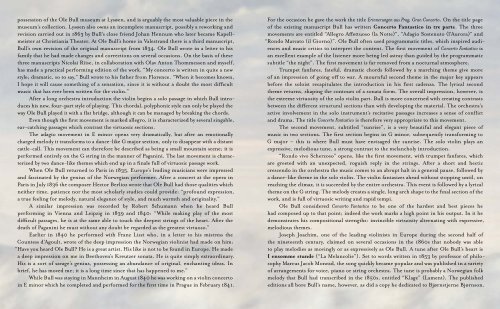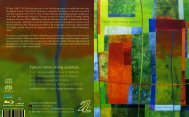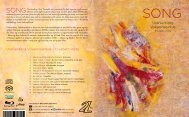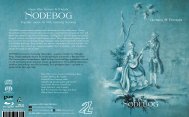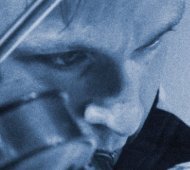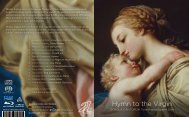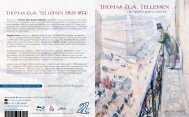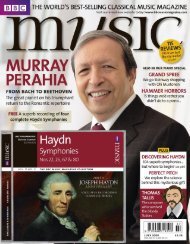*!0E1I8I-fbeice! - 2L
*!0E1I8I-fbeice! - 2L
*!0E1I8I-fbeice! - 2L
Create successful ePaper yourself
Turn your PDF publications into a flip-book with our unique Google optimized e-Paper software.
possession of the Ole Bull museum at Lysøen, and is arguably the most valuable piece in the<br />
museum’s collection. Lysøen also owns an incomplete manuscript, possibly a reworking and<br />
revision carried out in 1863 by Bull’s close friend Johan Hennum who later became Kapellmeister<br />
at Christiania Theater. At Ole Bull’s home in Valestrand there is a third manuscript,<br />
Bull’s own revision of the original manuscript from 1834. Ole Bull wrote in a letter to his<br />
family that he had made changes and corrections on several occasions. On the basis of these<br />
three manuscripts Nicolai Riise, in collaboration with Olav Anton Thommessen and myself,<br />
has made a practical performing edition of the work. “My concerto is written in quite a new<br />
style; dramatic, so to say,” Bull wrote to his father from Florence. “When it becomes known,<br />
I hope it will cause something of a sensation, since it is without a doubt the most difficult<br />
music that has ever been written for the violin.”<br />
After a long orchestra introduction the violin begins a solo passage in which Bull introduces<br />
his new, four-part style of playing. This chordal, polyphonic style can only be played the<br />
way Ole Bull played it with a flat bridge, although it can be managed by breaking the chords.<br />
Even though the first movement is marked allegro, it is characterized by several singable,<br />
ear-catching passages which contrast the virtuosic sections.<br />
The adagio movement in E minor opens very dramatically, but after an emotionally<br />
charged melody it transforms to a dance-like G major section, only to disappear with a distant<br />
cattle-call. This movement can therefore be described as being a small mountain scene; it is<br />
performed entirely on the G string in the manner of Paganini. The last movement is characterized<br />
by two dance-like themes which end up in a finale full of virtuosic passage work.<br />
When Ole Bull returned to Paris in 1835, Europe’s leading musicians were impressed<br />
and fascinated by the genius of the Norwegian performer. After a concert at the opera in<br />
Paris in July 1836 the composer Hector Berlioz wrote that Ole Bull had those qualities which<br />
neither time, patience nor the most scholarly studies could provide: “profound expression,<br />
a true feeling for melody, natural elegance of style, and much warmth and originality.”<br />
A similar impression was recorded by Robert Schumann when he heard Bull<br />
performing in Vienna and Leipzig in 1839 and 1840: “While making play of the most<br />
difficult passages, he is at the same able to touch the deepest strings of the heart. After the<br />
death of Paganini he must without any doubt be regarded as the greatest virtuoso.”<br />
Earlier in 1840 he performed with Franz Liszt who, in a letter to his mistress the<br />
Countess d’Agoult, wrote of the deep impression the Norwegian violinist had made on him:<br />
“Have you heard Ole Bull? He is a great artist. His like is not to be found in Europe. He made<br />
a deep impression on me in Beethoven’s Kreutzer sonata. He is quite simply extraordinary.<br />
His is a sort of savage’s genius, possessing an abundance of original, enchanting ideas. In<br />
brief, he has moved me; it is a long time since that has happened to me.”<br />
While Bull was staying in Mannheim in August 1840 he was working on a violin concerto<br />
in E minor which he completed and performed for the first time in Prague in February 1841.<br />
For the occasion he gave the work the title Erinnerungen aus Prag, Gran Concerto. On the title page<br />
of the existing manuscript Bull has written Concerto Fantastico in tre parte. The three<br />
movements are entitled “Allegro Affettuoso (la Notte)”, “Adagio Sostenuto (l’Aurora)” and<br />
“Rondo Marcato (il Giorno)”. Ole Bull often used programmatic titles, which inspired audiences<br />
and music critics to interpret the content. The first movement of Concerto Fantastico is<br />
an excellent example of the listener more being led astray than guided by the programmatic<br />
subtitle “the night”. The first movement is far removed from a nocturnal atmosphere.<br />
Trumpet fanfares, fateful, dramatic chords followed by a marching theme give more<br />
of an impression of going off to war. A mournful second theme in the major key appears<br />
before the soloist recapitulates the introduction in his first cadenza. The lyrical second<br />
theme returns, shaping the contours of a sonata form. The overall impression, however, is<br />
the extreme virtuosity of the solo violin part. Bull is more concerned with creating contrasts<br />
between the different structural sections than with developing the material. The orchestra’s<br />
active involvement in the solo instrument’s recitative passages increases a sense of conflict<br />
and drama. The title Concerto Fantastico is therefore very appropriate to this movement.<br />
The second movement, subtitled “sunrise”, is a very beautiful and elegant piece of<br />
music in two sections. The first section begins in G minor, subsequently transforming to<br />
G major – this is where Bull must have envisaged the sunrise. The solo violin plays an<br />
expressive, melodious tune, a strong contrast to the melancholy introduction.<br />
“Rondo vivo Scherzoso” opens, like the first movement, with trumpet fanfares, which<br />
are greeted with an unexpected, roguish reply in the strings. After a short and hectic<br />
crescendo in the orchestra the music comes to an abrupt halt in a general pause, followed by<br />
a dance-like theme in the solo violin. The violin fantasizes ahead without stopping until, on<br />
reaching the climax, it is succeeded by the entire orchestra. This event is followed by a lyrical<br />
theme on the G string. The melody creates a single, long arch shape to the final section of the<br />
work, and is full of virtuosic writing and rapid tempi.<br />
Ole Bull considered Concerto Fantastico to be one of the hardest and best pieces he<br />
had composed up to that point; indeed the work marks a high point in his output. In it he<br />
demonstrates his compositional strengths: invincible virtuosity alternating with expressive,<br />
melodious themes.<br />
Joseph Joachim, one of the leading violinists in Europe during the second half of<br />
the nineteenth century, claimed on several occasions in the 1860s that nobody was able<br />
to play melodies as movingly or as expressively as Ole Bull. A tune after Ole Bull’s heart is<br />
I ensomme stunde (“La Melancolie”). Set to words written in 1853 by professor of philosophy<br />
Marcus Jacob Monrad, the song quickly became popular and was published in a variety<br />
of arrangements for voice, piano or string orchestra. The tune is probably a Norwegian folk<br />
melody that Bull had transcribed in the 1850s, entitled “Klage” (Lament). The published<br />
editions all bore Bull’s name, however, as did a copy he dedicated to Bjørnstjerne Bjørnson.


